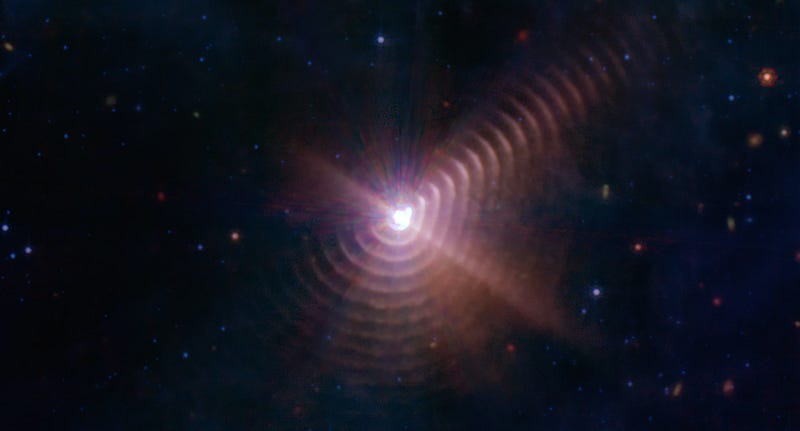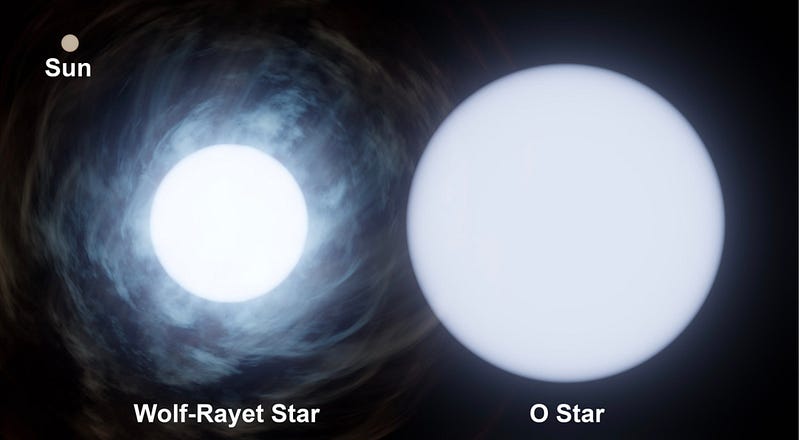Decoding the 'Cosmic Spiderweb': Insights from the James Webb Telescope
Written on
Chapter 1: The Cosmic Conundrum
A perplexing image captured by the James Webb Space Telescope (JWST) has left astronomers scratching their heads for months. The striking photograph, showcasing a distant star encircled by square-like concentric patterns, ignited speculation across the internet, with some suggesting it could be an alien megastructure spanning light-years.
The image in question depicts the binary star system WR140, located approximately 5,600 light-years away, and was taken in July 2022, shortly after JWST commenced its scientific operations. It instigated heated debates online, with experts like Mark McCaughrean, a senior advisor at the European Space Agency, labeling the image as “bonkers.”
However, two Australian astronomers have clarified the mystery in recent studies published in Nature and Nature Astronomy. They reveal that the 17 unusual concentric rings around the star are not signs of extraterrestrial activity but rather massive dust shells produced by the periodic interactions of two hot stars, one of which is a dying Wolf-Rayet star, in a close orbit.
“Every eight years, WR140 emits a beautifully formed smoke ring, which is then expanded by the stellar wind like a balloon,” explained Professor Peter Tuthill from the Sydney Institute for Astronomy. “This image represents 150 years of orbital activity. Each time the stars approach, a beautifully crafted dust shell is expelled into space, nesting within the previous one. It resembles a grand set of Russian dolls.”

Section 1.1: Stellar Dynamics
The WR140 binary consists of a substantial Wolf-Rayet star and an even larger blue supergiant, bound together in an eight-year orbit. Unlike typical stars, the winds produced by Wolf-Rayet stars resemble a cosmic hurricane, hurling a barrage of material enriched with silicon and carbon into space.
The elements expelled through stellar winds condense into soot, which remains sufficiently hot to emit bright infrared light. The resulting dust clouds provide observatories with a clear view of their movement through space.
Because these stars follow elliptical orbits, the production of dust fluctuates as the stars approach and retreat from one another. Tuthill and his former student, Yinuo Han, developed a three-dimensional model of the dust plume's structure based on observations made since 2006. Their model successfully elucidated the peculiar results obtained by JWST.

Chapter 2: Unveiling the Mechanism
In their Nature publication, Han and Tuthill provided the first direct evidence of starlight colliding with matter and accelerating it, after observing enormous dust plumes generated by the intense interactions between these massive stars over 16 years.
Starlight exerts a force known as ‘radiation pressure,’ which can push matter, but capturing this phenomenon in real-time is exceptionally rare. “To measure acceleration effectively, the material must be relatively close to the star or the radiation pressure must be exceptionally strong,” said Han. “WR140’s fierce radiation enhances these effects, allowing us to gather precise data.”
Employing interferometry—an imaging technique that acts like a zoom lens—they captured remarkably clear images of WR140 for their research.
The first video, "James Webb Solves One of the Biggest Mysteries in Cosmology: Dark Ages and Reionization," delves into the broader implications of such discoveries, showcasing how JWST is revolutionizing our understanding of cosmic phenomena.
The data revealed that instead of the dust forming a hazy sphere as previously thought, it actually condenses where the stellar winds from the two stars collide, creating a rotating shock front. The dust forms a spiral pattern similar to that created by droplets from a garden sprinkler.
“In the absence of outside forces, the dust spirals should expand at a steady speed,” noted Han. “Initially, we struggled to align our model with the observations until we realized we were witnessing something novel—the acceleration was not constant, but increasing.”
Incorporating this acceleration into their model enabled them to explain the observational data effectively, clarifying the origin of the peculiar concentric rings captured by JWST.
The second video, "Hubble telescope spies a cosmic 'spider web' containing clues to dark secret," adds another layer of understanding to cosmic structures, emphasizing the importance of such findings in the field of astronomy.
“It was astonishing,” remarked Tuthill. “I never anticipated the image would be so striking. These concentric rings have even been likened to ‘God’s thumbprint’ in various online discussions.”
As JWST continues its operations, astronomers are poised to uncover more about WR140 and similar systems. “The Webb telescope provides unparalleled stability and sensitivity,” stated Dr. Ryan Lau, a lead author of the JWST study published in Nature Astronomy. “This will simplify observations that were previously challenging from ground-based telescopes, revealing new insights into Wolf-Rayet physics.”
The unique characteristics of WR140 ensure it will remain a source of intrigue for astronomers. “I have a deep fascination for this system. Wolf-Rayet stars are uncommon, and WR140 stands out due to its immense wind and elliptical orbit with a blue supergiant—it’s truly a heavyweight duel in the universe.”